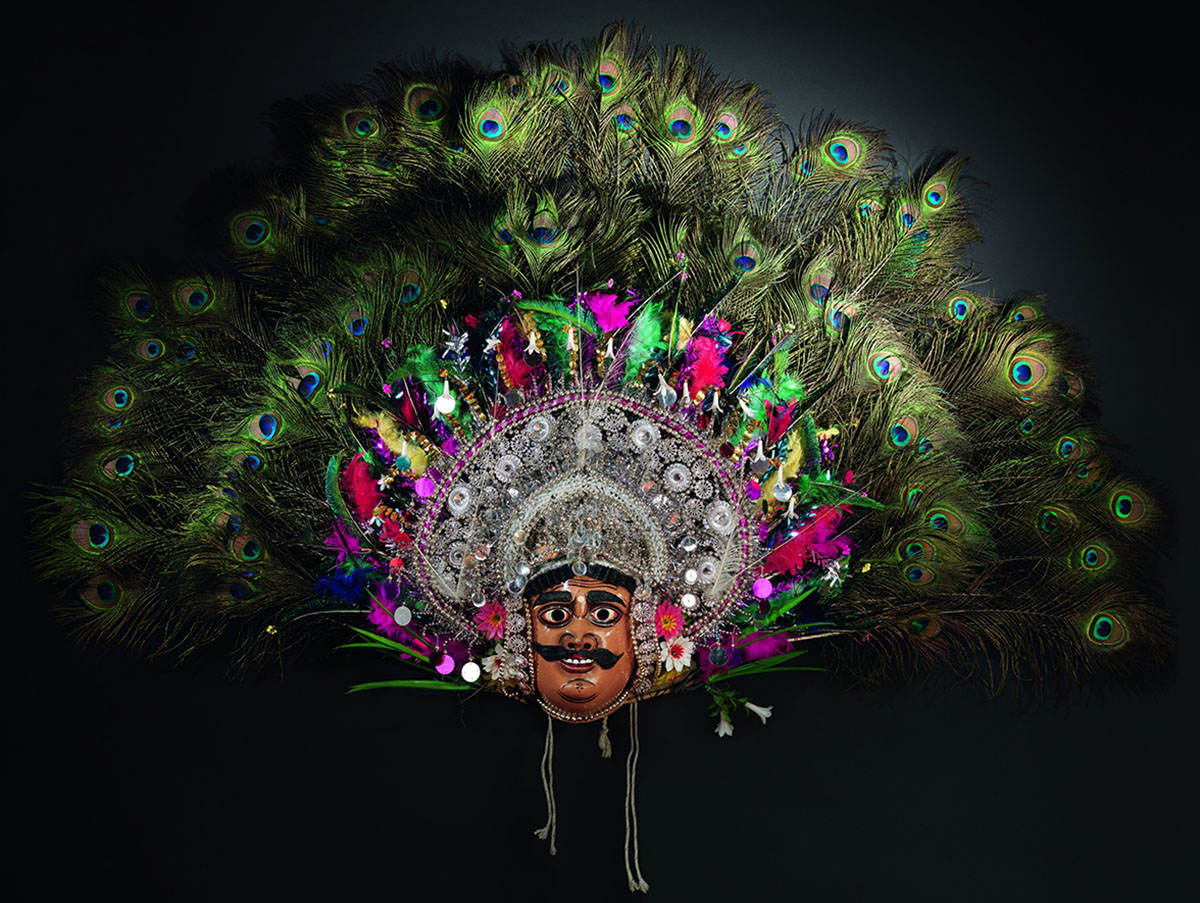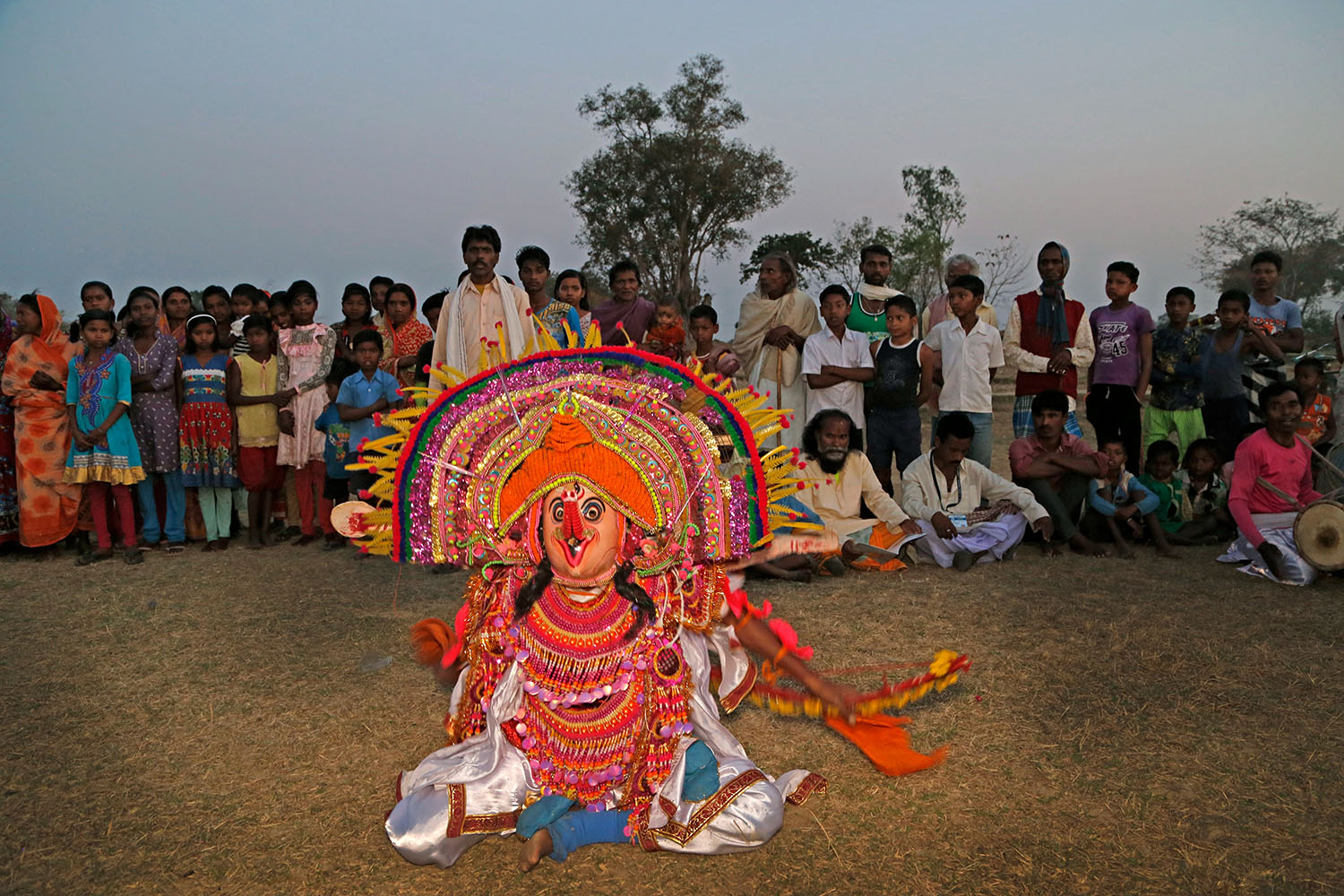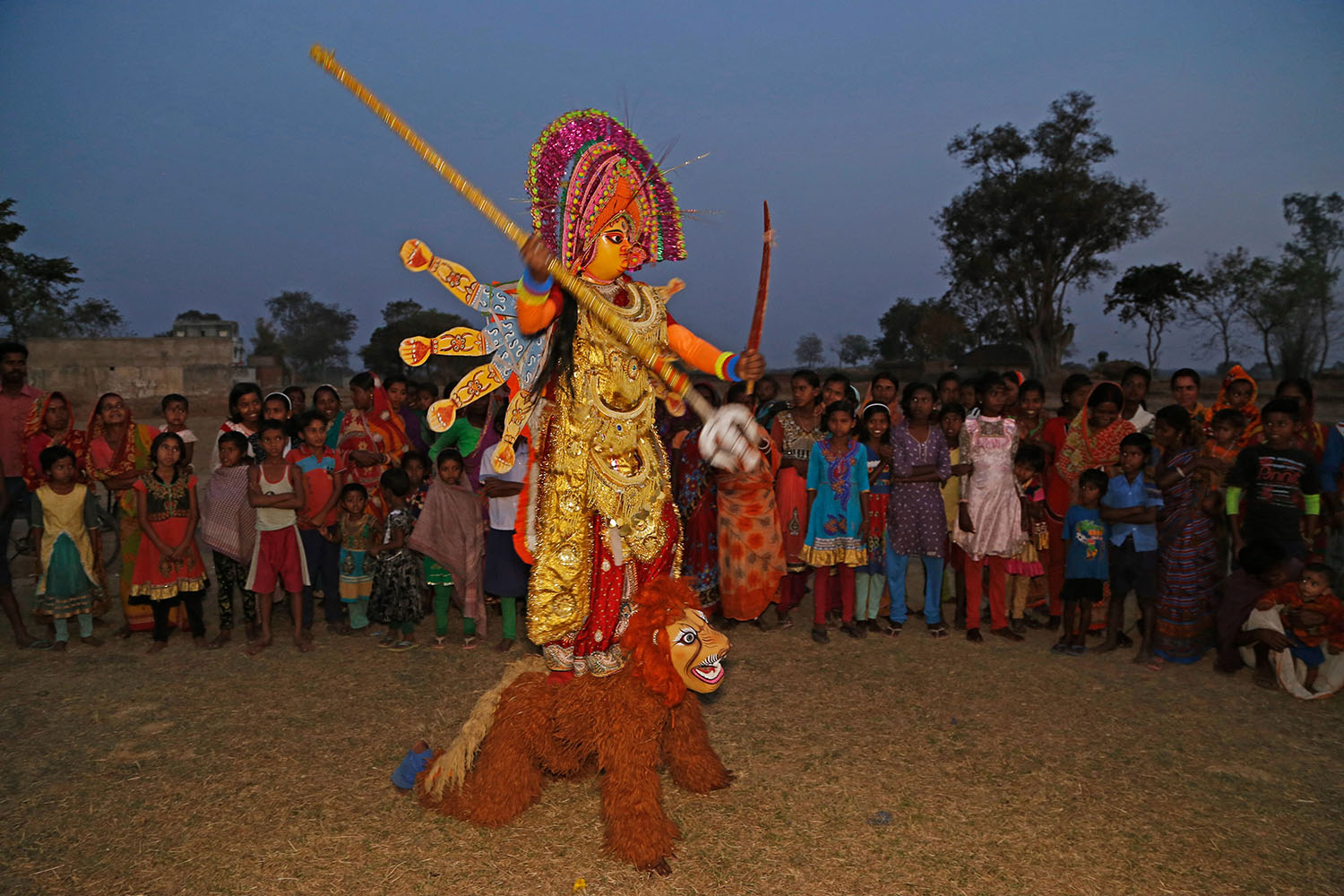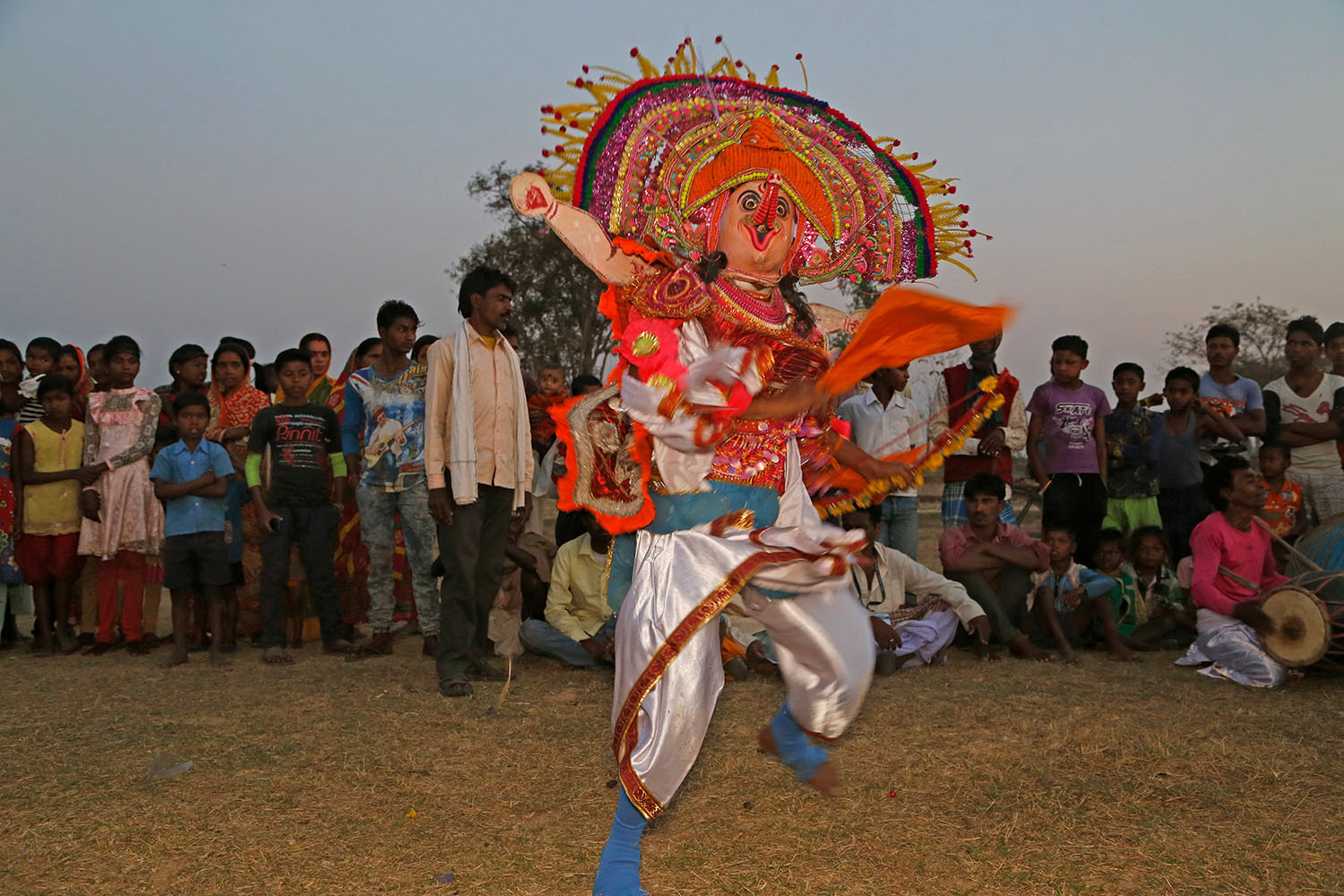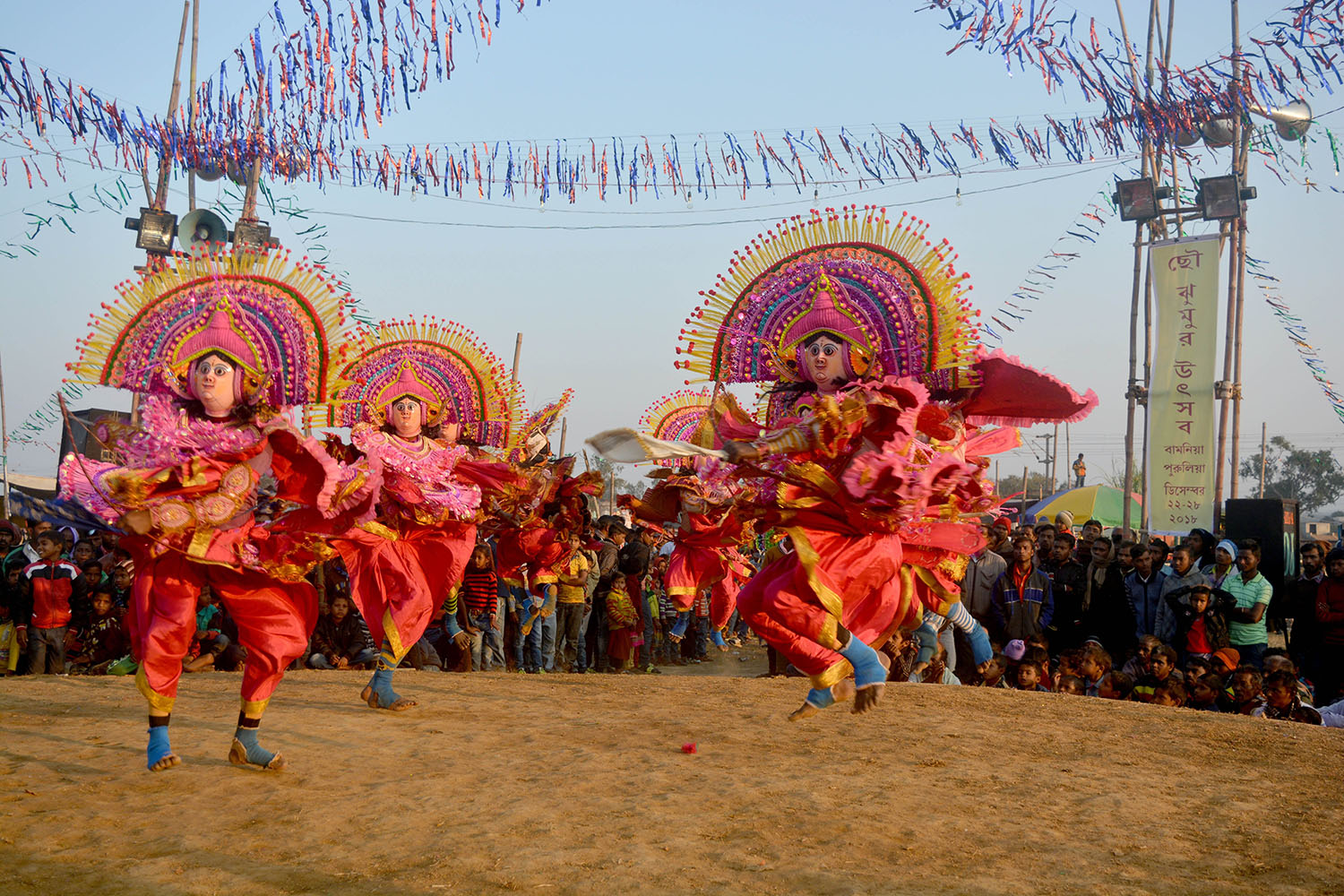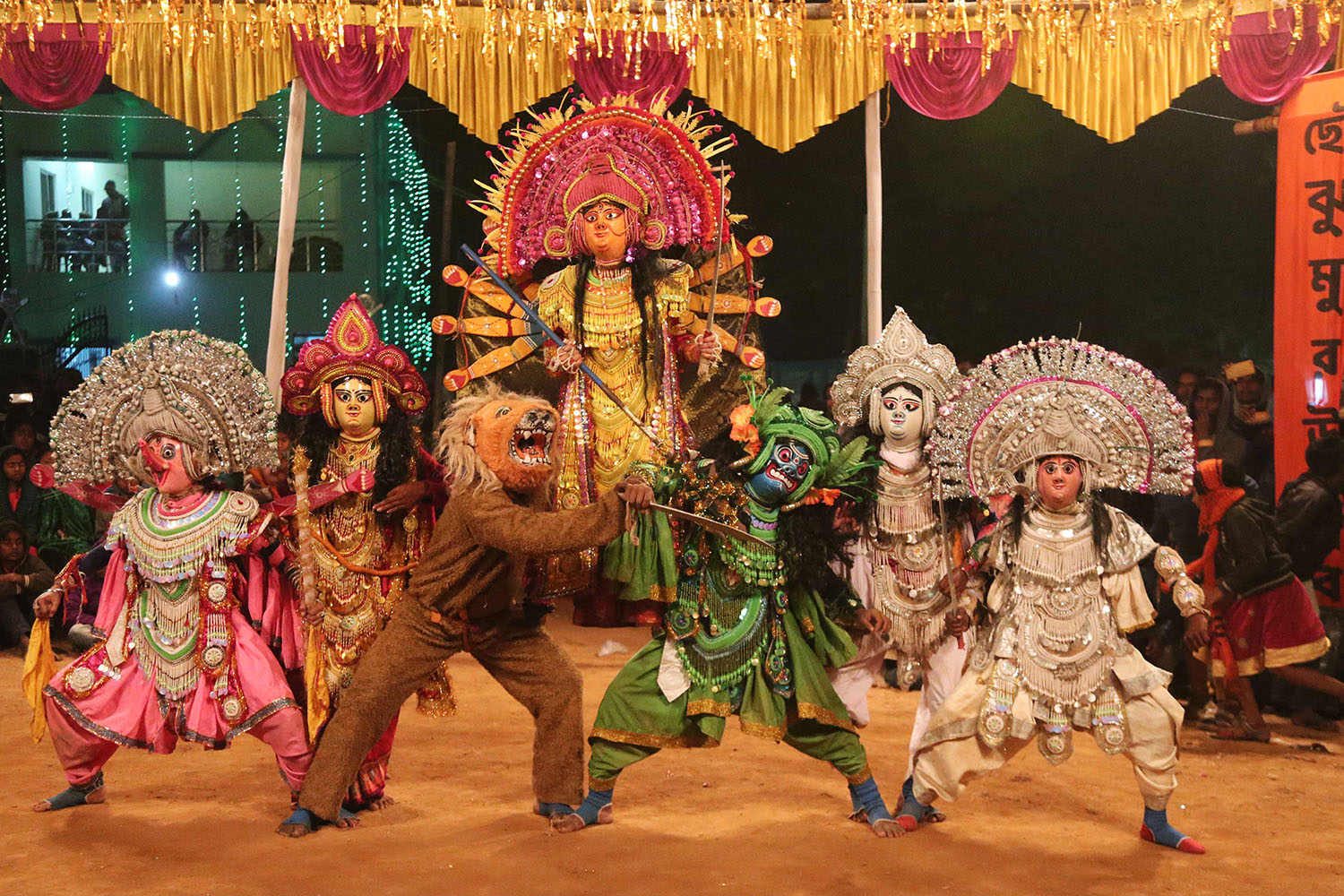ARTICLE
Chhau
A folk performance form that incorporates martial arts and dance-drama elements, chhau is performed in the states of Jharkhand, Odisha and West Bengal. Each state has distinct styles of chhau — Seraikela chhau in Jharkhand, Mayurbhanj chhau in Odisha and Purulia chhau in West Bengal. Chhau performances originally took place during the spring festival of Chaitra Parva in April, which celebrates the deities Shiva and Shakti in the Ardhanarishwara form. Over the last few decades, it has begun to be performed throughout the year.
The origins of the word “chhau” are debated. Possible sources include the Odia words chhauni (military camp), chhauka (checking something stealthily) and chhauri (armour), suggesting that it may derive from military practices. Another possibility is that the word is derived from the Sanskrit word chhayi, meaning shadow, illusion or image, referring to the use of masks in some forms of chhau. The Odia words chhabi (picturesque), chhai and chhatak (clowning) have also been suggested as possible origins.
Until the end of the twentieth century, only men would participate in and perform chhau, but women performers have become more visible since. These individuals are organised into troupes, which move in search of work. Mayurbhanj and Purulia chhau are performed primarily by members of Scheduled Castes, whereas Seraikela is primarily performed under royal patronage by men from the Kshatriya (warrior) caste.
Chhau emphasises footwork and the movement of the entire body, rather than mudras. Instead, chhau performers’ hands are held tightly in fists or kept open, imitating the grasping of a sword and shield. Instruments typically used include the mahuri (a conical double-reed pipe), dhol (a percussion instrument), nagara (a large drum played with wooden sticks), dhumsa (a kettle shaped single headed drum), and chadchadi (a flat percussion drum).
The narratives of chhau are borrowed from Puranic texts, and epics such as the Mahabharata and Ramayana. A single performance generally lasts for about forty-five minutes to an hour, and includes different episodes or stories. If multiple troupes are performing, such as during a village festival, performances last for four or five hours. The performative repertoire consists of stylised movements to depict action only through the feet, known as uflis, as well as nature-inspired bodily movements depicting animals and birds, known as challis and topkas. Other standard movements include the baagh chaali (tiger walk), mayur chaali (peacock walk) and khel (variations on ufli and swordplay). The forms are not derived from a text, with the traditions and forms passed on generationally within troupes.
Chhau troupes may be grouped into overarching schools within the three broad regional styles.These include Uttara Sahi and Dakshin Sahi within Mayurbhanj chhau, and Bazar Sahi and Brahmin Sahi for Seraikala chhau. All three styles of chhau are believed to derive their movement elements from the martial arts practice of parikhanda, wherein pari denotes shield and khanda denotes sword. A distinguishing feature between the styles is the use of masks. Both Seraikela and Purulia chhau incorporate masks in their performances, whereas Mayurbhanj chhau does not. This means that Mayurbhanj chhau uses both facial expressions and bodily movements to express emotion in dance drama sequences, while Seraikela and Purulia chhau emphasise bodily gestures as the performers’ faces are covered with masks. Seraikela and Mayurbhanj chhau both received considerable royal patronage over the nineteenth and twentieth centuries, which impacted their performative repertoire. Purulia chhau, in comparison, retains influences from the martial arts from which chhau may derive.
As a dance form, Seraikela chhau is deeply influenced by its usage of masks which constrain the movement of the performer. It thus emphasises subtle movements of the neck (known as grieve bheda) and the head (siro bheda). Though light, the mask makes it difficult for the performer to breathe and thus restricts the length of a typical Seraikela chhau to no more than ten minutes. The basic stance is known as dharan, wherein the knees are bent and both feet turned outwards with the left foot in the front. The body weight typically rests on both legs. Seraikela chhau is usually practiced in solo performances, with some duets and troupe performances. Though most of the performers are men, eighteen of the standard thirty-six feet movements in Seraikella chhau represent the everyday routines of women. Some popular dances within this style dances include ratri (night), depicting a playful game between the moon and the night; sabar (hunter), in which a hunter is depicted waiting for his prey; mayur (peacock), wherein the dancer evokes the bird through elaborate neck and upper body movement; astra danda (martial art movements) and Radha-Krishna (playful dance representing the god Krishna and his consort). Seraikela chhau gained immense popularity under the aegis of Kumar Bijay Pratap Singh Deo of the Seraikela royal family, who choreographed and performed this style of chhau in a form that has continued to the presentas it is recognised in its present form. He also promoted the form internationally by taking the chhau dancers for a tour to Europe in 1938, cementing its contemporary position as one of Jharkhand’s foremost performing arts. It was under his patronage that women first began to perform chhau, joining his troupe on their Europe tour; women have been part of Seraikela chhau troupes since.
Purulia chhau incorporates acrobatic and energetic movements accompanied by elaborate masks representing gods and demons from Hindu mythology. The narratives tend to focus on episodes of combat from the Puranas, depicted using athletic skills. Popular dances include Mahishasura Badha, depicting the defeat of the demon Mahishasura by the goddess Durga and Ravana Badha, a duel between Rama and Ravana characterised by the use of high-pitched sound and vigorous movement. The performances typically begin with a song to Ganesha, followed by a rousing call to action for the dancers. Purulia chhau is traced to the work of the twentieth-century dancer Gambhir Singh Mura, who contributed significantly to the choreography and forms that the dance is recognised with today.
Mayurbhanj chhau divides its performative elements into movements depicting birds and animals, along with thirty-six feet movements. The execution of these movements, however, differ from Seraikella chhau. Mayurbhanj dancers adopt the basic stance from the tribhangi (standing position) from Odissi, with the body weight resting on one leg. The dancers also emphasise their upper body movements more than in Seraikella chhau. The movements can be categorised into three types — Kalibhanga or delicate, lyrical movements; Hatiyardhara or forceful, masculine movements and Kalikata, which combines the two. The absence of masks in this form allows for more acrobatic movement. Some significant dances include the solo dance Nataraja, represented by dancers from the Uttara Sahi tradition, depicting the god Shiva. The Dandi dance is performed by dancers from the Dakshina Sahi tradition, and is based on the Upanayana or sacred thread ceremony.
Mayurbhanj chhau traces its origins to the masked Ram-Leela performances of the Baripada district in Odisha, and also incorporated influences from the Seraikella chhau. Scholars have also suggested similarities to ritualistic dances by the Santhal community, a tribe residing across much of east-central India. During the reign of Maharaja Jadunath Bhanja in the mid-nineteenth century, one Madan Singh Bapu from Baripada combined music from Ram-Leela with that of chhau. Master performers Upendra Biswal and Banamali Das were then brought into the region to train dancers, leading to the creation of the two schools of Uttara Sahi and Dakshin Sahi. After the annexation of princely states in the region following the independence of India, royal patronage ceased, adversely impacting Mayurbhanj chhau.
The state government of Orissa (now Odisha) extended patronage to chhau from the 1950s by establishing annual grants and through the establishment of training centres. Chaitra Parva, the spring festival, generally includes chhau performances in Odisha, and many Chaitra Parva celebrations receive state support as well.The Sangeet Natak Akademi runs special training centres for chhau dancers. Chhau was recognised as an Intangible Cultural Heritage of Humanity by UNESCO in 2010.
Bibliography
Acharya, Indranil. “Aestheticizing without Agenda: A Counter-Reading of the Western Approach to Chhau.” Rupkatha Journal on Interdisciplinary Studies in Humanities vol. 5, no. 3 (2013): 89–96.
Gan, Pradeep Kumar and Sanjeeb Kumar Mohanty. “The Chhau Dance of Mayurbhanj: Its Growth and Royal Patronage.” Orissa Review, April 2005: 46-49.
Mahapatra, Sitakant. “Chhow Dance of Mayurbhanj: The Tasks Ahead.” Mumbai: National Centre for the Performing Arts, 1978. Republished in Sahapedia. Accessed October 12, 2021. 31–44.
Ponikiewska, Asha. “Stories Behind the Masks.” Sahapedia. September 13, 2017. Accessed October 12, 2021. https://www.sahapedia.org/stories-behind-the-masks.
Reck, David. “The Music of Matha “Chhau.”” Asian Music vol. 3, no. 2 (1972): 8–14.
“On the Chhau of Purulia: Interview with Roma Chatterjee.” Sahapedia, March 9, 2017. Accessed October 12, 2021. https://www.sahapedia.org/the-chhau-of-purulia-interview-roma-chatterjee.




